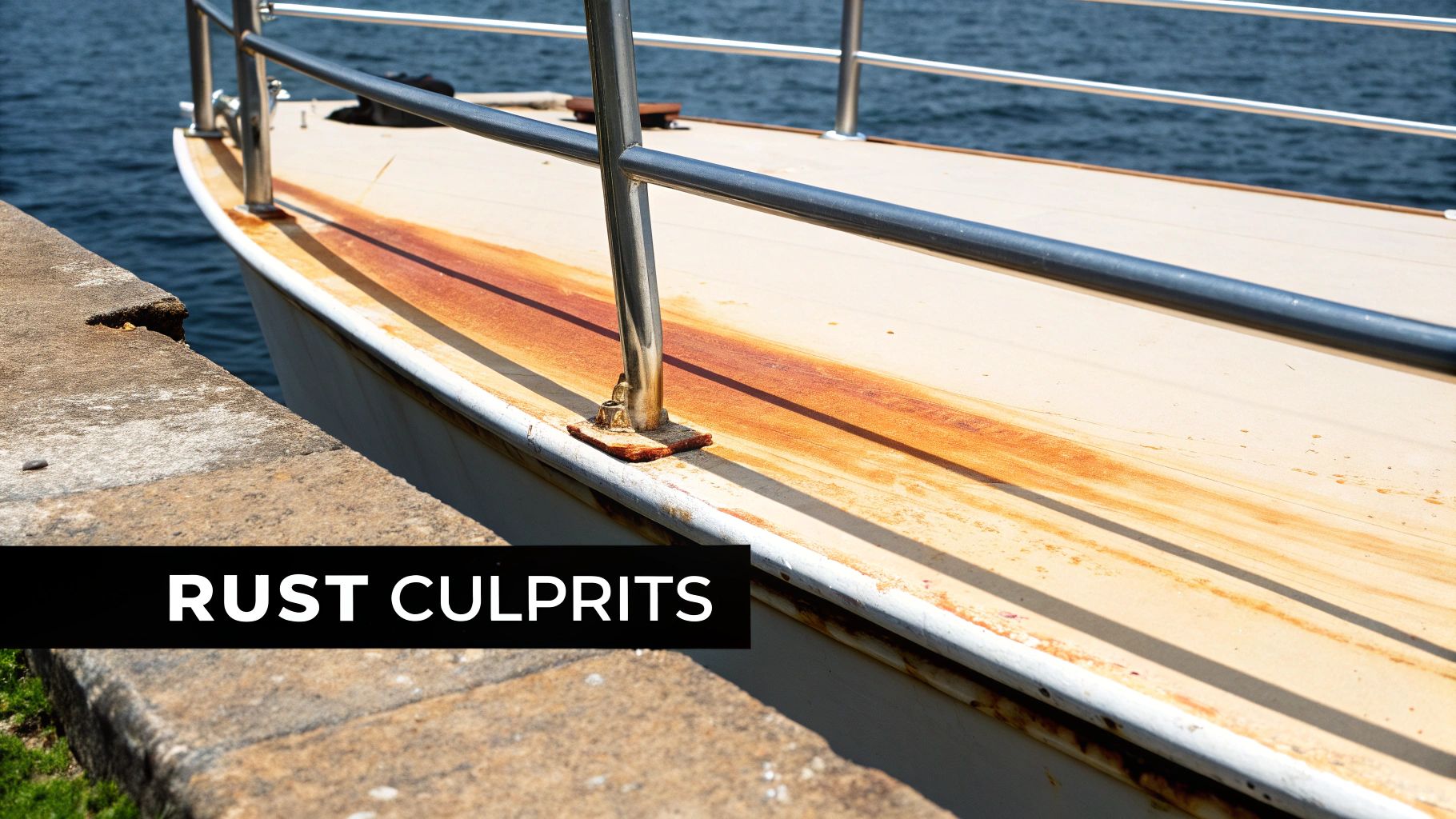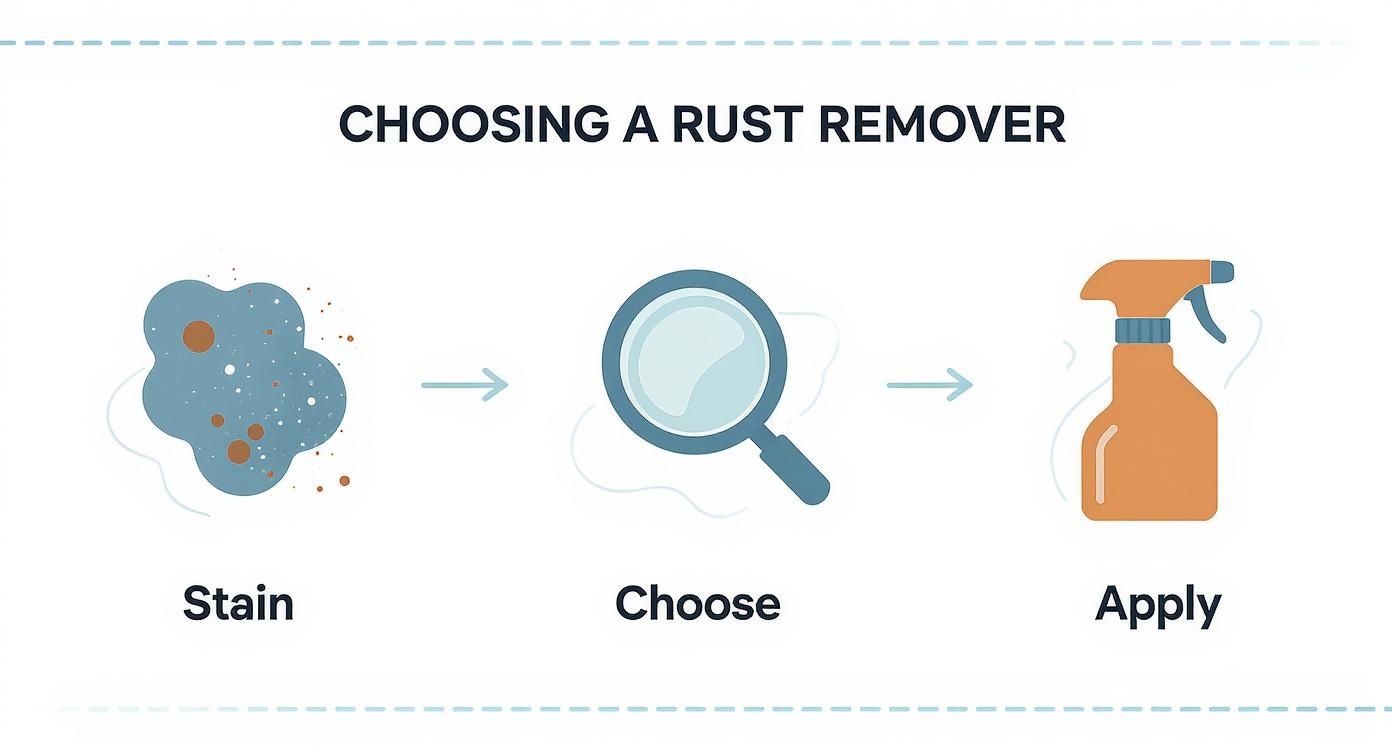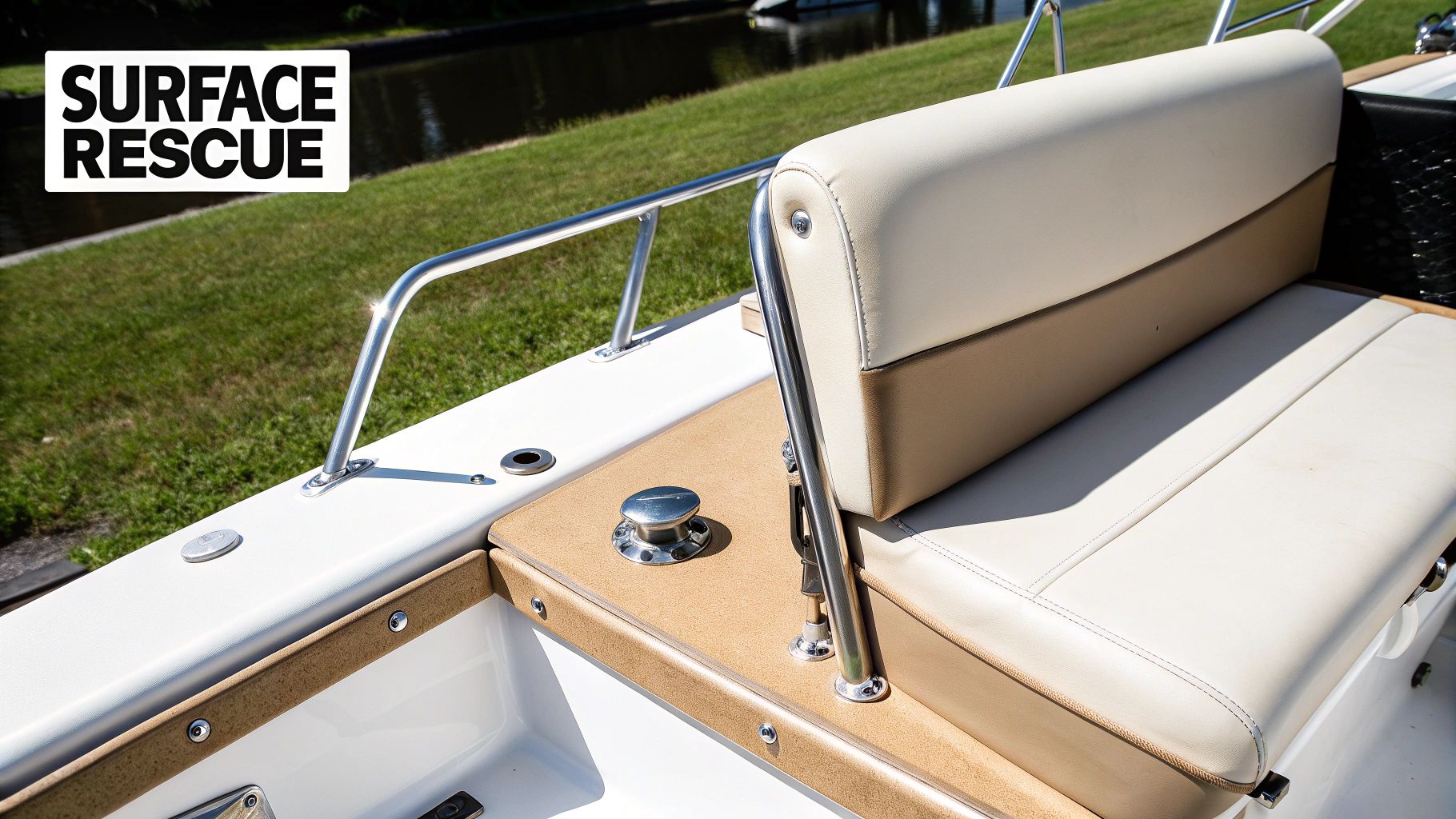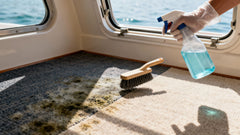How to Remove Rust Stains from Your Boat
Before you can get rid of those ugly rust stains on your boat, you have to play detective. The obvious culprits are easy to spot—metal fittings like screws and railings that are constantly battling saltwater. But rust has a sneaky side. It can come from less obvious places, like tiny flakes from your anchor chain or even the water at the dock if it has a high iron content.
Tackling the stain is only half the battle. Figuring out where it came from is the real key to making sure it doesn't come right back.
What Really Causes Rust Stains on Your Boat

Those nasty orange streaks running down your hull aren't just a surface problem. They're the result of a chemical reaction called oxidation. When any iron or steel on your boat gets exposed to oxygen and moisture—which, let's face it, is a 24/7 reality in the marine environment—it starts to corrode.
Those resulting iron oxide particles then get washed down your boat's surfaces, embedding themselves into the gelcoat and leaving a stain that feels impossible to remove. This is a massive headache for boat owners and a big reason why there's a huge market for specialized marine cleaning products.
Common Rust Culprits Hiding on Your Boat
You'd be surprised by how many things can leave a rust stain on a seemingly pristine boat. Hunting down the source is your first mission. Once you know what you're dealing with, you can figure out the best way to get rid of the rust and stop it from returning.
Here are the usual suspects I see all the time:
- Metal Hardware: This is the big one. Aging or lower-quality stainless steel screws, railings, cleats, and stanchions are prime offenders. Over time, their protective chromium layer breaks down, and the corrosion party starts.
- Anchor and Chain: Every time you drop and retrieve your anchor, tiny metal flakes can chip off the chain and land on your deck. You might not even see them, but after a bit of morning dew, you'll find a nice little collection of rust spots.
- Tools and Fishing Gear: We've all done it. Left a wrench out after a quick fix or dropped a fishing hook on the deck. That's a surefire way to find a perfectly shaped rust stain after the next rain shower.
- High-Iron Water: Sometimes, the problem isn't even on your boat. If your marina has "hard water" with high iron content, just hosing down your boat can leave behind mineral deposits that oxidize and stain your beautiful white finish.
Rust isn't just a boater's problem. The global market for rust removers was recently valued at a whopping $553.59 million. Marine applications make up a solid 5–10% of that demand, which shows just how common this issue is on the water. You can explore more insights on the rust remover market to see the bigger picture.
Choosing Your Rust Removal Toolkit
When you're staring down an ugly orange stain marring your boat's beautiful finish, you’ve got two main ways to tackle it: a dedicated commercial formula or a trusty DIY solution. The right choice really comes down to the stain itself, the surface you're cleaning, and how much elbow grease you're willing to put in.
For those tough, set-in rust stains on durable surfaces like gelcoat, a specialized product is usually your best bet. Formulations like rust stain remover are the heavy artillery, using powerful but safe acids to dissolve the iron oxide particles right at the chemical level. This is what you bring out when a stain has been baking in the sun for weeks and just laughs at other cleaners.
Commercial Rust Remover vs DIY Solutions
On the flip side, plenty of seasoned boaters swear by simple items you probably already have in your galley. A bit of white vinegar, some lemon juice, or a paste made from baking soda and water can be surprisingly effective on lighter, fresher stains. These are fantastic options for more sensitive surfaces like vinyl, or just for anyone who prefers to start with a milder approach before bringing out the big guns.
Deciding between a purpose-built cleaner and a home remedy can be tough. To make it easier, here’s a quick breakdown of what you can expect from each.
| Attribute | Commercial Rust Remover | DIY Solution (Vinegar/Lemon Juice) |
|---|---|---|
| Effectiveness | High, especially on tough, old stains. Designed for maximum impact. | Moderate, works best on light or very fresh stains. |
| Speed | Fast-acting, often requires minimal scrubbing. Just spray, wait, and rinse. | Slower, may need to sit for a while or require multiple applications. |
| Surface Safety | Formulated for specific marine surfaces like gelcoat and fiberglass. | Generally safe, but you always need to do a spot test first. |
| Cost | Higher initial investment for a specialized product. | Very low cost, uses common household items you likely already own. |
At the end of the day, both have their place in your boat cleaning arsenal.
Making the Right Call
Think of it this way: a commercial cleaner is like calling in a specialist for a stubborn problem, while a DIY method is your trusty first-aid kit for minor issues.
For a deeper dive into what works best for all sorts of blemishes—from waterline scum to bird droppings—check out our comprehensive guide on choosing the right boat stain remover. It'll help you match the right tool to whatever mess you find on deck.
Safely Removing Rust from Fiberglass and Gelcoat
Your boat’s fiberglass hull and gelcoat finish are built tough, but they're not invincible. When you're dealing with a rust stain on these surfaces, the trick is to be aggressive enough to lift the stain but gentle enough to avoid scratching or hazing the finish. It’s a delicate balance, but totally achievable with the right approach.
Before you even reach for a rust remover, give the stained area a good wash. Just use some quality boat soap and fresh water. This simple step gets rid of any loose salt, dirt, or grime that could get ground into the gelcoat and cause scratches while you're working. Once it's clean and you’ve got your gloves and safety glasses on, you’re ready to tackle the stain itself.
This workflow breaks down the basic process, from spotting the stain to getting it gone.

As you can see, choosing the right product is just as critical as how you apply it.
The Right Application Technique
Whether you're using a commercial product or a DIY paste, the actual application is pretty straightforward. Always try to work on a cool surface out of direct sunlight. If the hull is hot, cleaners can evaporate way too quickly, which makes them less effective and can leave a nasty residue behind.
Apply your chosen rust remover right onto the stain, making sure it's completely covered. Now for the most important part: patience. Let the product sit and do its thing for the time recommended on the label, usually somewhere between 5 and 15 minutes. This dwell time is crucial because it allows the active ingredients to get in there and chemically break down the rust.
Pro Tip: Whatever you do, resist the urge to scrub with all your might. If you have a really stubborn stain, use a soft-bristle brush or a microfiber cloth to gently work the area. This helps lift the dissolved rust without scratching the delicate gelcoat.
Once the time is up, rinse the area thoroughly with plenty of fresh water. You want to wash away every trace of the cleaner and the stain, which neutralizes the chemical reaction and leaves you with a bright, clean finish.
It's no surprise that more and more boaters are tackling these jobs themselves. The DIY segment now accounts for nearly 20% of rust remover sales in the U.S., thanks to countless online guides showing people the ropes.
For a deeper dive into prepping your boat's surfaces, check out our complete guide on how to clean a fiberglass boat.
Tackling Rust on Vinyl and Metal Surfaces

Rust doesn’t just plague the hull. We've all seen it: those ugly orange stains that seem to magically appear on pristine vinyl seats and gleaming stainless steel hardware. These surfaces are far more delicate than fiberglass, so you can't just blast them with the same heavy-duty cleaners.
Using the wrong chemical can cause permanent damage, like discoloration on your cushions or scratches on your railings. The trick is knowing how to approach each material the right way.
Restoring Your Vinyl Upholstery
When it comes to vinyl, gentle is the name of the game. An aggressive, acid-based cleaner might work wonders on your gelcoat, but it will absolutely destroy a boat seat. It's much better to start with a milder method that won't strip the color or compromise the material.
For light stains, a simple 50/50 mix of white vinegar and water can work surprisingly well.
- Always do a spot test. Before you go all-in, find a hidden area (like under a cushion) to test your marine vinyl cleaning solution. This little step can save you from a big, discolored headache.
- Blot, don't scrub. Use a soft microfiber cloth to apply the solution. Gently blot the stain. If you scrub too hard, you risk grinding the rust particles deeper into the vinyl's texture.
- Rinse it clean. Once the stain is gone, wipe the area with a fresh, damp cloth to get rid of any leftover cleaning solution.
If you're dealing with tougher stains or just want a reliable go-to for maintenance, a dedicated product is your best bet. Our guide to choosing the right marine vinyl cleaner has some great pointers.
Remember, the goal is to lift the stain, not the color. Aggressive scrubbing or using the wrong chemical on vinyl is a one-way ticket to a costly reupholstery job.
Polishing Up Metal Hardware
Surface rust on stainless steel fittings—think cleats, railings, and hardware—is a common sight on any boat that sees regular use. For this, you want a non-abrasive approach.
A good metal polish paired with a soft cloth will usually take care of light rust and bring back that mirror shine without scratching the surface. When you're looking for a good cleaner for stainless steel, make sure it's designed to prevent future corrosion while restoring its appearance.
Proactive Strategies to Prevent Future Rust Stains
Getting a tough rust stain off your boat is a great feeling, but keeping it from showing up in the first place is the real victory. If you can shift your mindset from cleaning to prevention, you'll save yourself a ton of scrubbing down the road. It all boils down to building a few simple habits.
Get in the routine of walking your boat and giving all your metal hardware a quick look. When you spot the first hint of corrosion on a cleat, screw, or stanchion, you can tackle it right then and there—before it has a chance to drip down and bake into your gelcoat. Trust me, this tiny check makes a huge difference.
After you've successfully cleaned a rust stain, what you do next is absolutely critical.
Create a Protective Barrier
Applying a high-quality marine wax to the freshly cleaned area isn't just a suggestion; it's a must. Think of it as an invisible shield that repels water and stops corrosive elements from getting into the tiny pores of your gelcoat. If you skip this step, you're pretty much just setting the stage for the next stain.
Here are a few other preventative tips that have saved me countless headaches:
- Rinse with Fresh Water: After every single trip in saltwater, give your boat a thorough freshwater rinse with a boat hose. It’s a simple task that washes away the salt crystals that are rust's best friend.
- Upgrade Your Hardware: When it’s time to replace hardware, spend a little extra on 316-grade stainless steel. Its corrosion resistance is far superior to other grades and well worth the investment.
- Store Your Anchor Properly: Make sure your anchor locker has good drainage. A wet anchor chain sitting in a puddle is a guaranteed source of rust stains.
This preventative mindset isn't just for rust. It applies to all your marine gear. For example, knowing the proper servicing intervals for scuba regulators can prevent internal corrosion and failure. It’s the same principle: a little care now prevents big problems later.
Common Questions About Boat Rust Removal
When it comes to rust removal, a few common questions always pop up. Getting the right answers can save you from a lot of frustration and potential damage to your boat's finish.
Let's tackle a big one right away: household bleach. It might seem like a quick fix, but reaching for the bleach is a huge mistake. Bleach can’t chemically break down the metal particles that make up a rust stain.
Even worse, it's known to permanently damage gelcoat and weaken vinyl. It’s a costly error for what seems like an easy solution. Always stick with a product that’s actually made for the job.
Will a Rust Remover Strip My Wax?
Almost certainly, yes. Most effective rust removers are acid-based because that's what it takes to dissolve rust particles. Unfortunately for your wax job, that same acidity will cut right through any protective coating.
Don’t worry, this isn’t a problem—it’s just part of the process. Once you’ve zapped the rust stain and given the area a thorough rinse, you absolutely must reapply a quality marine wax. This isn't just for looks; it restores the UV protection and builds a barrier to prevent future stains from setting in.
What if the Rust Stain Just Won't Go Away?
Most rust stains are just on the surface. But if a stain has been sitting there for a season or two, especially on older, more porous gelcoat, it can work its way deep into the finish.
If you’ve tried a proper rust remover a couple of times and the stain isn't budging, stop scrubbing. You'll do more harm than good and risk damaging the gelcoat. At this stage, you're likely looking at a job for a professional who can wet sand and polish the area without causing further issues.
For every challenge on the water, Better Boat has a proven solution. Explore our full range of easy-to-use cleaning and maintenance products designed to protect your investment and keep your boat looking its best. Find your perfect rust remover and more at https://www.betterboat.com.





